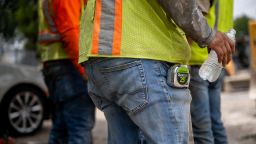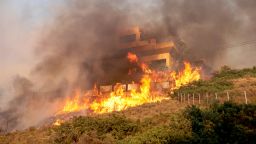It is so hot in Maricopa County, Arizona, that people are being brought into the emergency room with significant, sometimes life-threatening burns. For the past three or four weeks of this record heatwave, people have been burned just by falling on the ground.
“Summers are our busy season, so we anticipate that this sort of thing is going to happen. But this is really unusual — the number of patients that we’re seeing and the severity of injuries — the acuity of injuries is much higher,” said Dr. Kevin Foster, director of burn services at the Arizona Burn Center at Valleywise Health. “The numbers are higher and the seriousness of injuries are higher, and we don’t have a good explanation for it.”
Every single one of the 45 beds in the burn center is full, he said, and one-third of patients are people who fell and burned themselves on the ground. There are also burn patients in the ICU, and about half of those patients are people burned after falls.
“It has definitely taken its toll,” Foster said.
The area has been hotter than usual, even for Arizona, and that, experts said, means that the ground can be dangerous for anyone whose bare skin comes into contact with it.
Asphalt is dark and dense. While concrete is lighter and reflects some sunlight, when the sun shines on asphalt, its dark color causes it to absorb light and it heats up.
Since it is a dense material, it also holds the heat even after the sun has been shining on it.
On a hot day, asphalt can easily be 40 to 60 degrees hotter than the air, some studies show. Last Thursday, the air temperature reached 119 degrees Fahrenheit. Phoenix had six consecutive days at or above 115 degrees by Saturday; the streak ended Sunday, with high temperatures reaching only 114 degrees.
“The temperature of asphalt and pavement and concrete and sidewalks in Arizona on a warm sunny day or summer afternoon is 180 degrees sometimes. I mean, it’s just a little below boiling, so it’s really something,” Foster said.
It can take only a “fraction of a second” to get a “pretty deep burn,” he said. For people who have been on the pavement for 10 to 20 minutes, “the skin is completely destroyed” and the damage often goes down deep, meaning it is a third-degree burn.
Foster sees burns like that after people survive a house fire. “These are really serious injuries,” he said.
Patients with third-degree burns will require multiple surgeries and have to spend weeks or even months in the hospital and have years of reconstructive surgery and therapy. “It is a really substantial injury,” Foster said.
‘This is crazy that this is happening’
Around the United States on Monday, more than 35 million people are under heat alerts scattered across the western US, Plains and in South Florida. More than 5,000 heat records have been broken or tied in the US over the last 30 days, according to the National Oceanic and Atmospheric Administration.
Despite the extreme heat, most places aren’t seeing burn injuries right now. ER doctors say the most common heat-related illnesses they see are heat exhaustion and heatstroke.
Dr. Cecilia Sorensen, an emergency room doctor who has been working in an ER in Colorado this summer and is managing heat-related illnesses due to a heat wave there, said she hasn’t seen any burn injuries so far, but she knows they happen.
“There was some reports of that in the Pacific Northwest during the massive heat wave there a few years ago. Paramedics were getting burns all over their knees, because they were intubating unconscious victims on the concrete. So we’ve seen this before,” said Sorensen, who is the director of the Global Consortium on Climate and Health Education at Columbia University. “But I mean, this is crazy that this is happening,”
Dr. Frank LoVecchio, an emergency room doctor at Valleywise Health Medical Center in Phoenix, said he has treated a number of people for burns this heat wave.
“Depending on where they are, if they have a knee on the asphalt and it is in the open sun, then it takes just minutes and unfortunately we’re seeing that quite often,” LoVecchio said
LoVecchio said he treated an elderly patient who fell out of her wheelchair. Almost instantly, he said, she got burns all over her legs. A number of the people coming in with burns are unhoused and have gotten burned sleeping or resting on the pavement. He has also cared for patients who were outside working in the heat. Some have gotten exhausted or dehydrated, passed out and wound up with burns from being on the ground. He said one man he treated got exhausted, possibly doing yardwork, and fell over onto the concrete and had burns in so many places he will require skin grafts over several parts of his body.
While anyone can fall, people who tend to fall and get burned more often are elderly people with medical problems that make them unsteady, Foster said, or people who are using substances and pass out.
“It only takes a few seconds for you to get a third-degree burn,” LoVecchio said.
Pets face injuries, too
Animals can also get burned walking on hot concrete or asphalt, said Dr. Rena Carlson, president of the American Veterinary Medical Association.
“Prevention is the key,” Carlson said. Keep cats inside, and when you do have to walk a dog, take them out early in the morning or late at night.
“Early in the morning is really the best, because in the evening, you are walking on pavement and concrete that has been sitting out in the hot sun all day really heating up,” Carlson said.
Get CNN Health's weekly newsletter
Sign up here to get The Results Are In with Dr. Sanjay Gupta every Tuesday from the CNN Health team.
Carlson said while dogs do need to get out to relieve themselves during the heat of the day, make sure they stay on the grass as much as possible. Even sandy areas and dirt can soak up the heat of the sun and burn their paws. Dog booties can help provide some insulation and protection for the pads on their paws, but they also can disguise the hurt, she said, and it is possible that when they are trotting around in them, they may not realize how hot it is.
“Oftentimes, once you get them home, they then don’t want to stand up or they are licking their paws and the skin on the bottom of their paws starts to slough off,” Carlson said.
Staying in the air conditioning is best for dogs during heat waves, Carlson said. If they do have to stay inside, give them toys and puzzles and things to keep their brains and bodies occupied, she said.
“If you have to get them outside,” she added, “Just go out to do their duty and get back in as quick as possible.”
CNN’s Monica Garrett, Jason Kravarik and Stephanie Elam contributed to this report.



